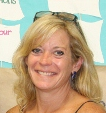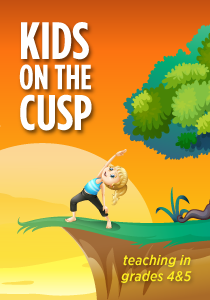But What Do You Teach?
A MiddleWeb Blog
We’re delighted to introduce Mary Tarashuk, an upper elementary school teacher in the scenic town of Westfield, New Jersey for 14 years. She’s been an integral part of bringing cultural arts assemblies into her school, presented new instructional strategies at district-wide parent information nights, and collaborated with colleagues to revise her district’s mathematics curriculum.
Mary also enjoys her current role as a creative consultant and content writer for The Walking Classroom and is working on her first novel. Most recently, her enthusiasm for hiking and nature inspired her to incorporate the outdoors into her teaching.
Mary will be blogging for MiddleWeb about Kids on the Cusp — what it means to teach and learn in grades four and five, with some special focus on “teaching it all.”
Let’s start with some of her backstory!
by Mary Tarashuk

After exchanging names and initial niceties, the topic of kids or work naturally comes up in conversation. In my case, both of these topics involve kids. My son is in middle school, and my daughter just completed fourth grade. I don’t ordinarily think of being a mom as my job, except on particularly harried days, so when someone asks me what I do, my standard reply has always been something along the lines of “I’m a teacher.” (Come to think of it, teaching doesn’t often feel like a job either.)
I must admit, the response from people is usually quite positive. People seem interested in teaching as a career. They can relate in some way. I guess we’ve all had teachers serve many different roles in our lives.
When people find out that I teach children, they usually smile and ask more questions. The conversation often goes something like this:
“So what do you teach?”
“I teach fourth grade.”
This is frequently followed by a similar question, with different voice inflection: “But what do you teach?

My new acquaintances tend to nod, and we end up swapping a few school stories. I’ve heard some treasures and a few sorrowful tales too. I enjoy talking to people about being a teacher. And it truly makes for some lively conversation. But what do I teach? It’s kind of a big question when you really think about it.
Kindergarten helpers and confidence
Teaching wasn’t my first career. I earned a BA in English, with a concentration in Journalism, from the University of Delaware. After postponing reality with a two-month backpacking trip through Europe (something I strongly suggest doing), I returned to New Jersey to start a career. The setting of said career would take place in nearby New York City, on the bustling, hopping, exciting island of Manhattan.
Manhattan was exciting, but the career, though an incredible adventure and positive experience, wasn’t long-lived. I found myself suddenly out of work and trying to figure out what I wanted to be when I grew up.
I thought back to sixth grade, when I was a Kindergarten Helper. I remembered volunteering as a junior counselor during my junior year of high school. We took dozens and dozens of sixth graders on a confidence-building weekend away from home to prepare them for Junior High, the middle school of my youth.
Both experiences were strong examples of controlled chaos. Both were immensely fun. After a bit of compulsive pondering, it finally occurred to me that I didn’t want to grow up entirely. I loved school when I was a kid. I loved learning. I don’t miss puberty one bit, for the record, but school was always something that held my interest and my attention. (Perhaps senior year in high school was an exception to the norm.)
I decided to apply to a graduate program and was accepted. I gave notice at the latest unfulfilling job, dug out my well-honed waitressing skills from undergrad, and headed back to school to become a teacher. That seems like a lifetime ago. Actually, it’s been about 20 years since I made that decision.
Pedagogy by day, prosciutto by night

There were classes on everything from classroom management techniques to assessment tools — teachers who had us do hands-on science and teachers who lectured. I took courses on lesson plan development and design, and can still probably bang out a Madeline Hunter lesson with ease, though I haven’t written one in years.
Eventually, coursework led to student teaching, bringing theory into the classroom. Life is funny. The deadline to set up student teaching was looming. I hadn’t been avoiding it. I’d just been a bit crazed. Finding a school close to home was vital, so I could make it to the restaurant for a 4:30 shift on most days.
One night, in the middle of the dinner rush, serendipity arrived. I walked over to my newest table of six to get things rolling. As I looked at the faces, I recognized my assistant principal from high school. He was a good man and did his best to help me whenever I needed it.
“Mary! Hello,” he boomed. He proceeded to introduce me to the table. “So how are things with you?” he asked, tilting his face up from his seat at the table and waiting for a response.
I remember feeling proud when I told him I was going to school to earn my Masters in Elementary Education. We chuckled at the irony. He was the disciplinarian in charge of attendance. The last marking period of senior year hadn’t been my finest, but he knew I was a good kid.
I told him I was trying to set-up my student teaching in an elementary school. With that, he turned to his wife, beaming, and proceeded to offer up her services as a mentor in her fifth grade classroom. I was thrilled. She was not. She put on a good face that night, but after we had worked together for a few weeks, she came clean.
Her classroom was my first exposure to something they couldn’t teach me at FDU: being in front of the kids, actually teaching them something. The school building was round. The classrooms were mini-amphitheaters, and there was a collapsible partition between every two, so one teacher could teach a double class during Science and Social Studies lessons each day. The professors at grad school couldn’t help me with figuring out how to manage a class of forty-five either. Come to think of it, that set-up was really insane. (My mentors were always present in the room in case I needed backup, but I was the one who was expected to do the teaching.)
I learned many valuable lessons that semester. Always send a note home before hands-on science activities that involve food coloring. Never sit in the back of the bus when going on field trips. Be open-minded about trying something new. My mentor wasn’t thrilled that her husband volunteered her to take me on as a student teacher, but she took a chance and gave it a shot. She told me she was glad she did.
Found my home in the goofy grades
After completing a stint as an aide for two years, in first and second grade classrooms, I went looking for a teaching job, quite certain that teaching really small children was not my forte. It takes a very special type of teacher to work with pre-school and early elementary kids. I am not one of those people.

To make this long story a tad bit shorter: I ended up in fourth grade, glorying in the goofy tween-ness of it all. But what do I teach? The answer to that essential question has morphed considerably as the years have passed.
Maybe I can begin to answer that question for myself with this opportunity to write for MiddleWeb. Maybe having conversations about effective teaching, finding out more about what you teach and think, will help us in developing and enhancing our craft. Thank you to MiddleWeb’s creators for supporting me as I work through my student-blogger experience on this remarkable website.
… I’m a little nervous. It’s kinda’ like the feeling I had on that first day of school, waiting for my first year to begin. Then suddenly, it just did…





































Mary – Looking forward to hearing your stories and learning from you! I also teach 4th grade, and love it for many of the same reasons you do… Like early elementary kids, you still get lots of hugs, they still think everything out of your mouth is gospel, yet they have some great basic skills to work with. My favorite thing? They haven’t really mastered the middle school “eye roll” just yet. ;)
Hi Mary,
I’m quite impressed with your article and look forward to reading more. I’m very pleased to have you as a member of the Wilson staff.
Thank you, Patti! We can learn together!…and I always counter an attempted eye roll with an eyebrow arch…Trumps it every time!…and thank you, Joe. Can I earn professional development hours for this?…kidding!
Glad to hear you’ll be sharing your experiences and passion for teaching “kids on the cusp” with MIddleWeb readers. I look forward to reading your blog!